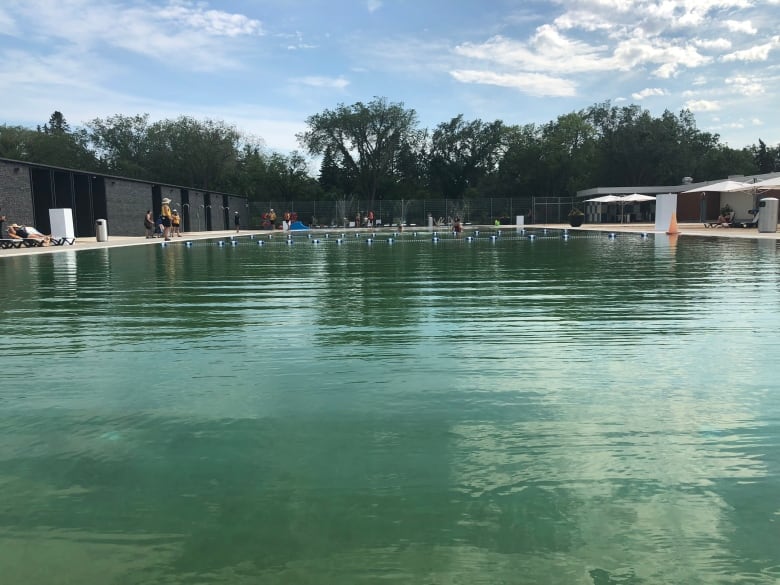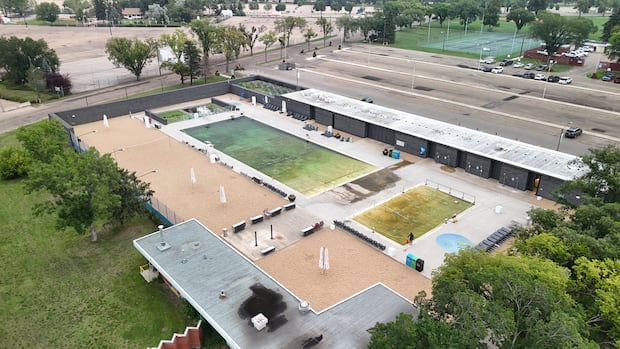
Years after public health researchers urged the City of Edmonton to allow no more than 45 swimmers per day in Canada’s only natural swimming pool, municipal officials say the water is just fine.
But microbiologists are concerned that allowing hundreds of people each day to take a dip in Borden Natural Swimming Pool is putting its fragile filtration system under unnecessary strain.
The city should adopt more stringent daily testing, said Jason Tetro, an Edmonton-based microbiologist, science columnist and author of The Germ Code.
“We really should be testing daily, particularly when we have higher bather loads and higher temperatures that could potentially lead to more microbial growth in those waters,” Tetro said.
“I probably wouldn’t swim in the pool right now because I know there is that added risk factor.”
Opened to fanfare in 2018, the $14.4-million pool relies on plants, zooplankton, granite and sunlight — rather than the conventional chlorine or salt — to filter the unheated water.
The kids’ pool was recently closed down due to unsafe levels of contamination — the second time it has been shut by Alberta Health Services this season due to unacceptable levels of contamination.
The main pool, overlooked by lily pads that are part of the filtration system, has remained open all summer despite algae blooms that are clouding the water.
The city allows up to 980 people per day in the pool, a capacity limit that far exceeds what researchers deemed necessary to keep the waters sufficiently clear of harmful bugs and bacteria.
A study, published in 2021 in the Journal of Water Science, found that the pool was slow to clear common contaminants. It recommended that capacity be constrained to no more than 45 swimmers daily to maintain an “acceptable level of risk” to swimmers and daily testing for fecal contamination.
‘Always a risk’
Nicholas Ashbolt, a co-author on the study, said all pools can harbour harmful germs, but it is especially critical that crowded pools that don’t use chemical disinfectants can effectively filter out pathogens.
“It’s always a risk to swim where other people are swimming, no matter what sort of pool,” said Ashbolt, who was a professor with the School of Public Health at the University of Alberta when the research was conducted in co-ordination with the city.
“The more people in the pool, that risk goes up.”
WATCH | Concerns surface about Canada’s only natural swimming pool:
Six years after it opened, the Borden Natural Swimming Pool, the only of its kind in Canada, remains a summer hot spot in Edmonton.
But microbiologists are concerned that too many swimmers may be putting the facility’s fragile filtration system under strain.
Ashbolt, now the Peter Teasdale Chair in Environmental Health Risk Assessment at the University of South Australia, said he was surprised to learn from CBC that the daily capacity had been set at 980.
In a statement, the city said “many mitigation measures” are in place to reduce the risk to Borden pool swimmers and address the concerns raised by researchers, including a strictly enforced rule that bathers take “head-to-toe” soaking showers before entering the pool.
The city said the pool operates “well below” recommended capacity limits.
“Based on the facility designer specifications, 980 was the number determined that the filtration system can support,” the statement said.
“These recommendations identified in the research are part of the operating practice of Borden Natural Swimming Pool.”

As of Aug. 19, Borden has welcomed an average of 187 users each day this season, with the highest single-day attendance hitting 661, the city said.
The city said it is not testing daily for fecal contamination. However, a batch of six water-quality samples is sent to Alberta Health Services each week as part of the site’s provincial monitoring requirements.
In addition, three weekly samples are collected for a University of Alberta monitoring program and testing is done daily for pH, phosphate levels and alkalinity.
City officials said the water is safe but acknowledge that algae growth has spiked with red and green blooms taking hold.
The water, usually a distinct emerald green, is currently brown.
Brenda Kibich took her children to the pool on Tuesday.
“You could see the green floating and settling on the bottom,” she said. “The algae on the bottom of the pool was pretty slippery. But we only had two falls this time.
“It was OK once you got used to it. Just slimy a bit at first.”
The city would not say what kind of algae was in the pool but said the red blooms are a naturally occurring species in Alberta.
It said algae remain at acceptable levels and that the blooms have been caused by excessive sunlight and nutrients from body lotions, shampoos and sunscreens.
Wildfire smoke is also likely to blame for giving the water a “brown tint,” the city said.
According to Ashbolt, the more likely culprit for the algae growth is something yellow.
“The most likely problem, rather than fecal accidents, is urination in pools despite, you know, people being told not to,” he said. “If there are too many people urinating in the pool, there will be excess nutrients.
And the most obvious microorganisms that will naturally grow are red and some of the other green algae.
“They are generally quite harmless. But they do represent excess nutrients in the water.”
‘Spiking’ study
For their study, researchers conducted a risk assessment during the design phase, followed by a “spiking study” as part of the commissioning process before the pool opened, Ashbolt said.
He said the research was the first of its kind. Natural swimming pools continue to gain popularity — there are thousands in Europe — but little research has been done on the ability of such facilities to filter out harmful pathogens present in all pools, he said.
Operators must carefully manage the risk of “likely urination,” of viral and urinary tract infections, and the expected frequency of something called “fecal shedding,” he said.
Bathers shed an estimated 0.14 grams of fecal material when they enter a pool, which is why pre-swim showering is so often enforced.
Viruses, bacteria and protozoa are the culprits in most swimming pool-related sickness outbreaks. Infected swimmers can introduce pathogens into the pool, contaminating the water.
Researchers spiked Borden pool with a cocktail of microbial surrogates that mimic waterborne pathogens that cause stomach aches, illness and infection.
The study tested for common threats including norovirus — the most common cause of gastroenteritis — and giardia, a diarrhea-causing parasite that often circulates in pools.
Researchers sought to measure how long it would take the pathogens to be filtered out by the pool’s filtration system and meet acceptable thresholds for the risk of illness.
The researchers measured against a U.S. Environmental Protection Agency benchmark, which allows for 35 gastrointestinal illnesses per 1,000 swimmers.
They found that if the pool were to become contaminated by a sick swimmer, certain pathogens, including norovirus, would linger for too long in the water, even after a full day of filtration.
“We estimated it would take more than 24 hours, after a heavy load of people, to clear the pool down to what we consider a safe level,” Ashbolt said.
“Because of the hydrodynamics, the way the water flows through the system, it would take at least a day to reduce the risk down to something acceptable and maybe longer.”
Accidents and unclean bodies
With a more crowded pool, the risk of someone having an “accident” increases, as does the overall rate of fecal contamination from unclean bodies, Ashbolt said.
He said the study’s projections were pessimistic and that the pool’s natural filtration system should have “improved with age” as the plants it relies on became more established.
He said the city has helped to mitigate the risks with frequent testing and campaigns that discourage people who are ill from entering the water.
But he said the city should undertake another “spiking” study to ensure Borden pool is safely handling the increased pressure from a greater number of swimmers.
Edmonton AM7:29Algae in Borden pool
The pool in Borden Park is a one-of-a-kind attraction which uses a natural filtration system instead of chemicals to clean the water. Over the summer, the algae has gotten a little thick on the ground. Microbiologist Jason Tetro explains it for us.
Chelsey McPherson swam in the pool for only the second time Tuesday and described the experience as “interesting.”
“It’s like an Alberta lake, it looks similar. It doesn’t look really appealing,” she said. “It’s just kind of green and darkish. I don’t mind it but it’s kind of a mind game you have to play with yourself.”
McPherson said she came for her first swim earlier this summer. She said the colour of the water left her with questions about monitoring, but she couldn’t find any details on recent inspections.
“When I had come and it was so dark … I was really curious, how safe is this water?”
Because Borden doesn’t use chemicals, it isn’t monitored as a pool under Alberta health regulations. Natural swimming pools are instead designated as general recreation water bodies and there are no standards limiting capacity.
Water quality testing for recreational swimming holes is voluntary and little information is shared with the public unless there’s a problem. Sites with high use and a history of poor water quality are designated as priority locations, and Borden falls on that provincial list.
In a statement, officials with AHS said water samples are submitted weekly and monitored through Enterococcus qPCR testing. Enterococci are used as a primary indicator of fecal contamination. And if elevated numbers are detected, its a warning sign that dangerous waterborne pathogens could be present.
If levels are between 1,280 and 6,400 calibrator cell equivalents (CCE) per 100 millilitres, microbial tracking is done to determine the source of contamination. Testing for CCE reflects the amount of bacterial genetic material present in the water, but secondary testing is needed to determine its source.
On July 16, sampling from the kids’ pool returned an unsatisfactory result and ultimately came back positive for human bacteria.
The kids’ pool will remain closed until there are two weeks of satisfactory samples, AHS said.
‘Not a beach’
Tetro, who was not involved in the filtration study at Borden pool, said regulating the facility as if it were equivalent to a lake or river is problematic. Tetro said the city needs to be more transparent about water quality so swimmers can choose what level of risk they are comfortable taking.
“It’s not a beach,” he said. “A river continually flows. A lake continually cycles.
“When we’re [enforcing] beach regulations, we’re really underestimating the risk.”
